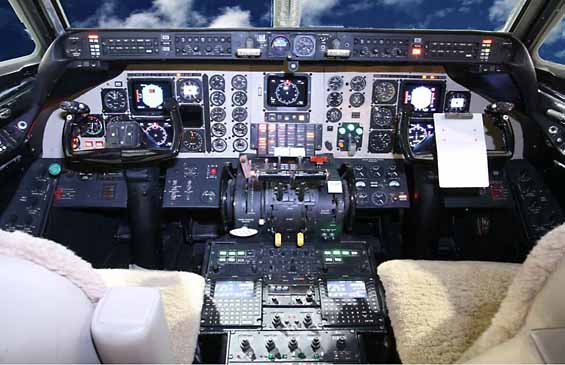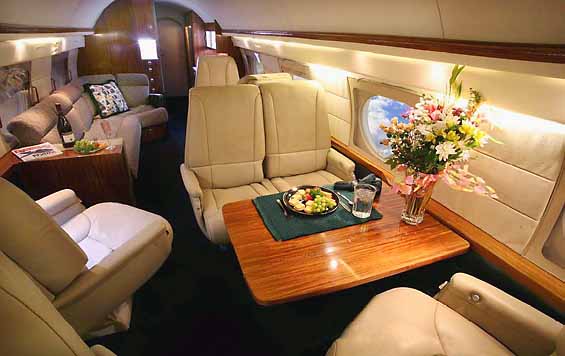


Aircraft Description
Background/History
The Gulfstream II was announced by Grumman in 1965 as a turbofan-powered replacement for the Gulfstream I turboprop executive transport. The transformation could hardly have been more thorough: the G-II was equipped with an entirely new swept wing, and a pair of Rolls-Royce Spey turbofans were mounted on pylons just ahead of an all-new T-tail. Only the large fuselage cross-section of the original Gulfstream was retained. For many years the Gulfstream II stood alone in its class, offering transcontinental range at jet speeds and the only standup cabin available in a business jet. To this day the Gulfstream line remains the standard by which large executive aircraft are measured. The Gulfstream II made its first flight in October 1966 and was granted FAA certification in October 1967. In 1976, Gulfstream engineers added tip-tanks to the wings which added an additional 4,000lbs. of fuel capacity and a corresponding 500nm increase in range. 256 G-IIs and G-IIBs were produced before the model was replaced by the G-III in 1979. The GIIB has the G-III wing with winglets, upgraded landing gear, increased gross weight and hush kits to quiet the Spey-powered Gulfstreams to Stage III specifications.
Power
The Gulfstream II is powered by a pair of Rolls-Royce Spey Mk 511-8 turbofan engines rated at 11,400 lbs. of thrust each. Inspection interval on the engines is 8,000 hours.
Avionics
The Gulfstream II was originally equipped with the analog comm/nav/ident radios and electromechanical instrument displays of the 1960’s and -70’s, although many have been updated. Typical installations include the Honeywell SPZ-800 system, with the Sperry SP-50G autopilot and dual Honeywell Laser INS, dual Collins CHF-20A comms, VIR-30 navs, dual DME, dual transponders, color weather radar, flitefone, and HF comms.
Design Features
The Gulfstream II is a transcontinental-range, twin turbofan powered business aircraft. It is configured as a cantilever swept low-wing monoplane with a swept T-tail. The airframe is of aluminum monocoque construction. Later production GIIs after 1976 incorporate wing tip-tanks adding an additional 4,000lbs. of fuel capacity resulting in a range increase of 500nm. The retractable tricycle landing gear has dual wheels on each unit. The wide fuselage is derived from that of the original Gulfstream I, and in fact all later developments in the Gulfstream line through the G-V utilize the same fuselage cross-section.
Accomodations
The Gulfstream II has been completed in a variety of configurations, but typical executive cabins accommodate 10 to 14 passengers in combinations of club seating, side divan, and individual passenger seats. The aircraft is commonly outfitted with a large working galley, entertainment center, and full-sized aft lavatory. The standup cabins of the Gulfstream line have long been some of the largest available in corporate aircraft. The GII cabin has a width of 7.3 ft., a cabin height of 6.1ft.and a length of 33.9ft.
| General | G-II, G-1159 | |||
|---|---|---|---|---|
| Category | Jet < 20,000 lbs. | |||
| Years Aircraft Manufactured | 1967 – 1979 | |||
| Serial Number Range | 002 – 258 (various) | |||
| Retail High Price | $3,250,000.00 / 2,550,275.00€ | |||
| Retail Low Price | $295,000.00 / 231,486.50€ | |||
| Characteristics | G-II, G-1159 | |||
| Seating | 2+12/19 | |||
| Wing Loading | 77.0 | |||
| Power Loading | 2.6 | |||
| Noise(EPNdB): Takeoff/Sideline/Approach | 103/98 | |||
| External Dimensions (ft) | G-II, G-1159 | |||
| External Length | 79.9 | |||
| External Height | 24.5 | |||
| External Span | 68.9 | |||
| Internal Dimensions (ft) | G-II, G-1159 | |||
| Internal Length (Overall/Net Height) | 33.9 | |||
| Internal Height | 6.1 | |||
| Internal Width (Max/Floor) | 7.3/5.5 | |||
| Baggage | G-II, G-1159 | |||
| External: Cu.Ft./Lb. | N/A | |||
| External: Cu.Ft./Lb. | N/A | |||
| Power | G-II, G-1159 | |||
| Engines | 2 RR Spey Mk 511-8 | |||
| Output (lbs ea.)/Flat Rating | 11,400 | |||
| Inspection Interval | 8,000t | |||
| Data based on latest manufactured year | ||||



